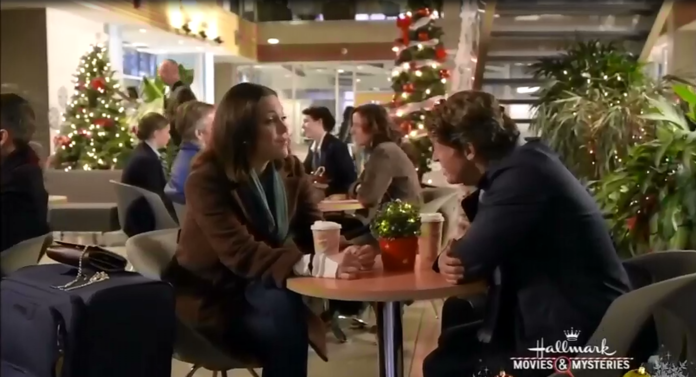Back in June, the Student Union Building (SUB) at UFV’s Abbotsford campus was taken over for a day while a movie crew shot a scene for a film. The SUB was decorated to look like an airport during the holidays, and while students walked past and whispered speculations about what was being filmed, the large, professional crew crafted a single scene in the Hallmark Movies & Mysteries (formerly Hallmark Movie Channel) original film Engaging Father Christmas. The film premiered on November 12, and The Cascade immediately found the scene featuring our campus. We’ve asked several of our writers to view the single, three-and-a-half minute long scene featuring the SUB, and to share their thoughts on the results of that long day’s work.
Cat
I have to admit, I love a good “bad” movie. Awkward line deliveries and inappropriate emphasis are my jam — if you’ve ever seen The Room, you know what I’m talking about. Unfortunately, Engaging Santa Clause is not the kind of “bad” I’m into — there’s no comedy here, only disappointment. If the the few minutes that were filmed in UFV’s SUB are any indication, this film as a whole falls flat.
From the clip that I viewed, there’s not anything unique about Engaging Santa Clause. The same generic Christmas season “we’ve been apart too long and I love and miss you” plot, the same generic, poorly delivered, sappy dialogue, and the same generic heterosexual love story.
I only watched a three-and-a-half minute clip, and let me tell you, things got wild. The plot moved from Miranda talking on the phone to her boyfriend, to Miranda running into an old ex-boyfriend, Josh, to Josh being a bit snarky (frankly, I would have said “bye boy” at this point), to Miranda revealing to Josh that her father that she never knew was a famous actor, to a mysterious man randomly bumping into Miranda’s suitcase (I sure hope they explain this better later in the movie), to Josh awkwardly kissing Miranda on the cheek, which of course Miranda’s new boyfriend is lucky enough to see — it wouldn’t be a Christmas romance without a little drama. But, you see why I’m a little overwhelmed; the viewer gets a boatload of information in only a few minutes. There’s no subtlety, no art to it.
Now, I understand that the majority of moviegoers enjoy romance and Christmas movies, but honestly, if directors insist on regurgitating the same love story over and over and over, give me some LGBT+ content, some people of colour, or some weird events or subplots that distract us, if only for a little while, from the fact that we’re watching the same movie that we’ve seen hundreds of times over.
Verdict: I’d rather eat tinsel than watch this movie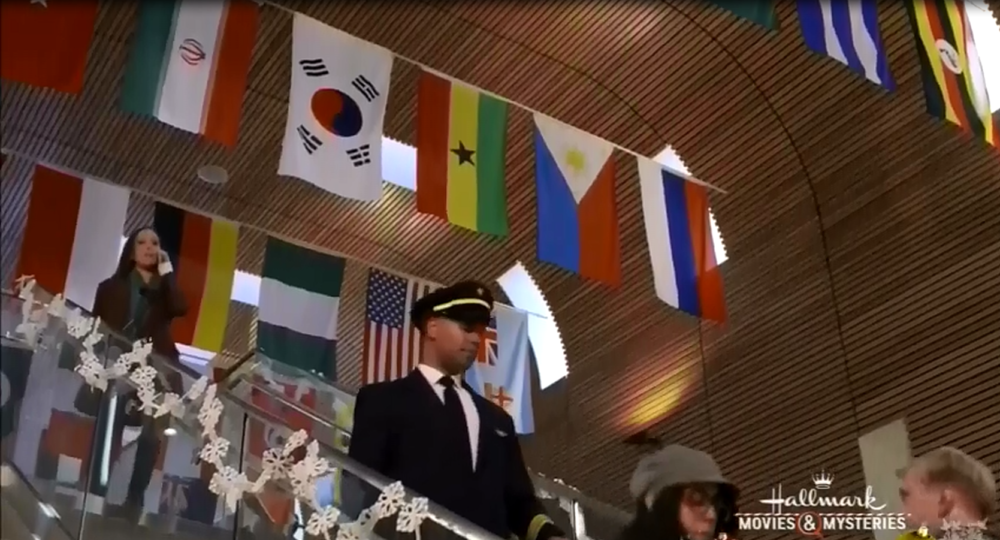
Joel:
After the scene opens on a shot of Miranda descending the stairs into a crowd of stranded travellers, she (by happenstance, orchestrated by the spirit Ariel) reacquaints herself with an old friend.
Miranda, in an attempt to deceive King Alonso of Naples’ son, Ferdinand, rattles off a story about her long lost father, and his recent death. In actuality, Prospero is alive and well, and is single-handedly responsible for King Alonso and his flight crew’s stranding at the Boston Logan Airport.
Miranda’s false love interest, Ian, whom she full on smooches after Ferdinand leaves to attend royal business, is actually Caliban, Sycorax’s son, and a deformed monster. He hides his identity with a hex.
Prospero and Alonso are brothers, but Alonso is a very bad boy. Alonso usurped power from Prospero, and Prospero’s only hope at regaining control of the kingdom is to pair his daughter with the son of his brother — how romantic.
From this scene alone, we see the reimagining of a classic tale. Although Engaging Father Christmas veers from the original source material, it successfully conveys the depth of deception, and showcases true human nature.
Verdict: In the true Shakespearean scene analysis tradition, I didn’t actually watch most of this scene.
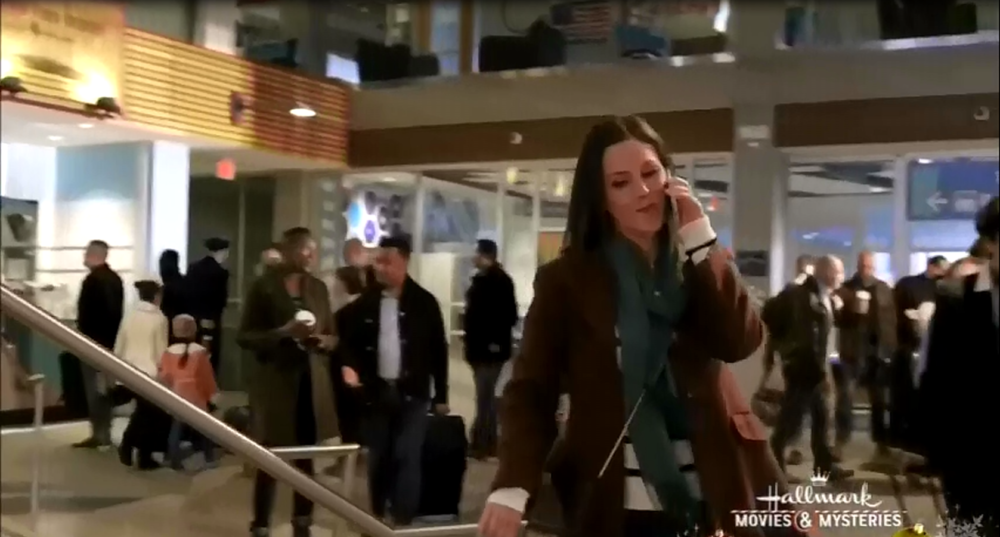
Mitch:
This scene is constructed right out of a textbook. The characters introduce the background and history of their relationship through back and forth expository dialogue. The shots are, save for the actors in frame, empty behind them. This is for two reasons. The first—it’s cheaper that way (network TV is a dying industry, after all) and secondly— so you aren’t conspicuous of the fact that two bland-faced actors are relaying half of the information of the scene.
The cinematography — it hurts to use this word to reference the camera work in this film — of the film breaks down like cookie cutter TV: wide, reverse wide, medium close up once they greet, close up shot once some sort of tension rises, and then a wide of the conversation to release tension. Rinse, and repeat.
The editor also used classic, basic film technique to establish that the SUB really is an airport for viewers. Stock footage shows a plane landing, followed by stock footage shot of a suitcase flopping onto a carousel, followed by a ridiculous amount of extras pulling suitcases back and forth in the SUB’s main atrium. Tah dah, now for all intents and purposes, the SUB has become an airport, with only a micro budget, and a couple of extras.
This scene is clearly meant for TV. You could swap channels and come across this clip and keep watching without having seen the first 45 minutes of the film. Consider this film the “Harlequin Romance” brand of film production. Cheap, quick, and people eat it up like it’s their last day in the chocolate factory.
Verdict: The quality of the filmmaking reminds me of the cookie cutters they use to make gingerbread men around this time of year.
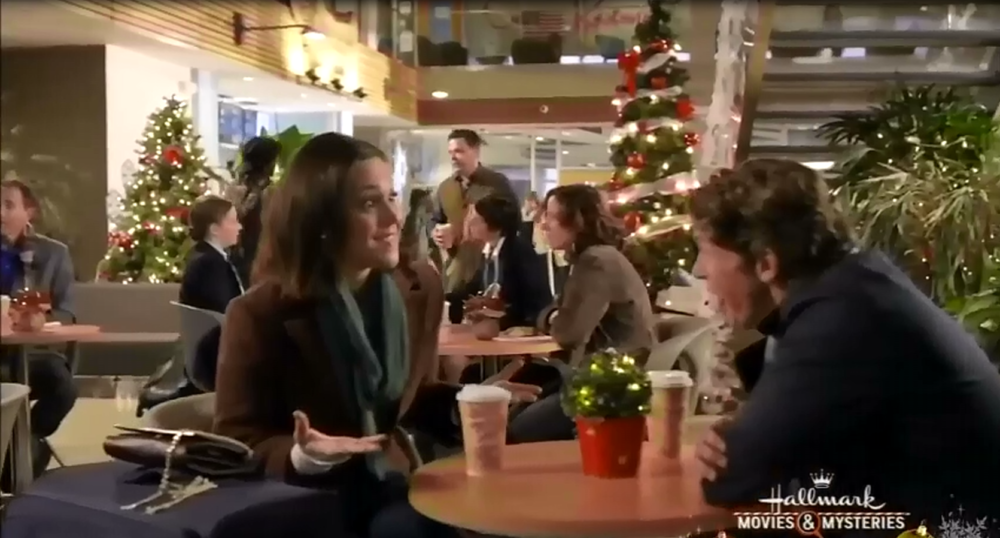
Jeff:
Do you like exposition? Engaging Father Christmas likes exposition! It likes it so much, that in this scene, it shoves the exposition right into your face, with absolutely no concept of subtext or subtlety. The scene shows two characters as Miranda Chester is spotted, and conveniently greeted using her full name, by Josh no-surname-given. The two sit down to talk about a past relationship between them, and mince no words as they blatantly remind the audience of what happened in their past.
“Oh yeah, that’s right,” says Josh, smiling like a loon as he spits out the words rapid-fire, “it was just after Christmas, the year before last, we decided we should uh…” he pauses as if it’s awkward, but doesn’t seem at all troubled. “…Take a break,” Miranda Chester finishes for him. Josh nods. “It was all very civilized, as I recall.” And that phrase, “as I recall” really sums up the scene. Because Josh says those words again right after, along with such choice exposition dump favourites as “do you remember?” and “of course, you said…” to remind Miranda Chester of details she absolutely would not need reminding of, just for the benefit of the audience.
Yes, this is a made-for-TV movie, so yes, they likely didn’t have time to get performances that everyone involved felt were perfect, or to decorate the set in as much detail as a Hollywood movie might, but c’mon. This is the script. Someone wrote this, and decided the best way to convey this information was in the most straight-forward, unnuanced dialogue that explicitly states the backstory. The same number of words could have conveyed the exact same information in any number of more dramatic ways.
Verdict: The movie might be Engaging Father Christmas, but the scene sure wasn’t engaging me.
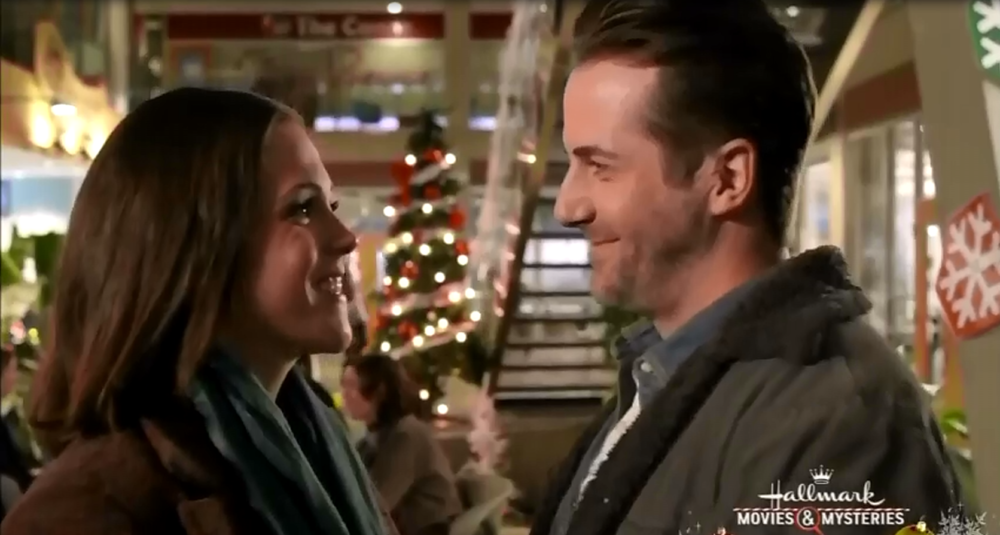
Martin:
The movie recently filmed in part at the SUB in Abbotsford is a terrifying surrealist masterpiece. Miranda, the main character, must grapple with what’s clearly a dissociative break from reality. She walks down a staircase and enters her own conscience, which manifests itself as a room filled with people carrying suitcases. These travelers symbolize the fleeting, momentary nature of Miranda’s cognitive stability — they are ready to jump ship at any second. Miranda carries no luggage, of course. Instead, it is waiting for her when she sits down at a table. In a metaphor that is perhaps a bit too on-the-nose, we’re shown that any suitcase would serve her: all the luggage shown is Miranda’s luggage.
It is only in this fugue state that Miranda can converse with “Josh”— a man she thinks is a friend from the past, but is obviously an extension of her own psyche (one she must confront if she is to free herself from the shackles of insanity). Asking him to keep it a secret, Miranda tells Josh that she has found her (now-dead) estranged “father.” As she says his name, “James Whitcomb,” a bell rings. This bell constitutes a motif of rare introspection on Miranda’s part as she inches closer to the truth: her fabricated father, James Whitcomb, is an actor, a masked man. Miranda’s subconscious is screaming at her: stop acting, face reality, or you will soon meet the same fate as Whitcomb!
Reaching an agreement with “Josh” not to divulge the secret to anybody, Miranda continues down the self-destructive path of denying herself the truth: Whitcomb’s existence is merely a ploy meant to keep her from realizing the extent to which her mind has shattered.
When her “boyfriend” (an undisputable personification of escapism) arrives, Miranda’s luggage has disappeared, and she runs to him before exiting the building. She leaves her fugue state having abandoned the suitcase (the only tangible remnants of her sanity) and, in an ending with horrifying implications, embraces him and the escapist hallucinatory highway that will no doubt drive her too far away from her sanity for recovery to ever be possible.
In a daring move, Hallmark has confirmed our long-held suspicions with the release of Engaging Father Christmas, its uncompromising artistic manifesto. With this film, Hallmark has finally outed itself as the post-modernist collective of fundamentally nihilist, surrealist masterminds we all suspected (and feared) that they were.
Verdict: Christmas comes but once a year, it’s true, but artistic genius like this comes but once a lifetime.


